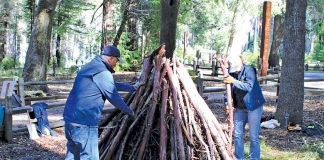
Although it’s a bit early around here to see fall colors it’s happening at the higher elevation. Or is it? Have the wildfires affected the changing of the leaves? And what about the effects of ongoing climate change? How is our planet changing?
Quaking aspen (Populua tremuloides) is the most widespread tree species in North America. They generally grow in high-altitude areas but also exist at sea level in places like the state of Washington along the Pacific coast where climate conditions are ideal. Quaking aspen provide food for foraging animals and a habitat for wildlife. They also act as a fuel break retaining much more water in the environment than do most conifer species.
High mountain systems, such as the Sierra Nevada, are uniquely sensitive to global climate changes and act as “canaries in the coal mine” providing early signals of significant climate-driven changes. Research in the Sierra Nevada by Pacific Southwest Research Station, a USDA Forest Service research organization, shows how vegetation has responded to climate in the past and indicates changes that might be coming in the future over the next decade.
Climate has a profound influence in shaping our environment and natural resources. By looking at tree ring records of living and ancient wood and pollen lake sediments present, climate can be compared to historic patterns to show climate changes.
Research indicates a complex, unpredictable future for aspen in the West, where increased drought, ozone and insect outbreaks will compete with carbon dioxide fertilization and warmer soils with unknown cumulative effects. Aspen are vulnerable in the face of climate change. Hopefully, we will not lose this wonderful tree in California.
Weather conditions play a major part in the intensity of fall color. The time of year is nearly consistent but some years the show is more dramatic than others. The best conditions for intense leaf color to develop are dry sunny days followed by cool, but not freezing nights.
Recent wildfires have had an effect on changing leaf color. Not much had been studied in this field prior to the 2018 fires that ravaged our state. Researchers’ measurements have shown that the total amount of sunlight available to a plant for photosynthesis decreased only slightly—about 4%—compared to the previous summer. The smoke didn’t block the light but scattered it. Direct sunlight might fall mainly on the upper foliage but diffuse light can reach a greater number of leaves throughout the canopy. So smoke can have some effect on photosynthesis but not much more than a cloudy day. Oxidative stress levels can occur during expended smoke exposure, however, so for the health of your plants be sure to wash the leaves off after a smoky day.
Which plants put on the best show in our area? Here are some of my favorites.
California native Western Redbud turns yellow or red in the fall if conditions allow. This plant is truly a four-season plant starting in spring with magenta flowers, then leafing out with apple green heart-shaped leaves. Colorful seed pods give way to fall color. This small native tree or large shrub does well as a patio tree in gardens with good drainage.
Other native plants like spicebush and Western azalea turn yellow or gold in the fall. A native vine that lights up with the onset of autumn is Rogers Red California grape. If you have an arbor, wall or fence that needs covering quickly this is your plant. The green and gray leaves are transformed in autumn into great draperies of rich, scarlet leaves with clusters of summer fruit turning all shades of purple.
Edibles that turn color in the fall include blueberries, pomegranate and persimmons.
Trees and shrubs that do well in our area and provide fall color include Chinese flame tree, ginkgo, Idaho locust, Chinese pistache, crape myrtle, witch hazel, all maples, liquidambar, katsura, dogwood, locust, cherry, crabapple, oakleaf hydrangea, barberry and smoke tree.
More on our own fall color later.
Jan Nelson, a landscape designer and California certified nursery professional, will answer questions about gardening in the Santa Cruz Mountains. Email her at ja******@*ol.com, or visit jannelsonlandscapedesign.com.










